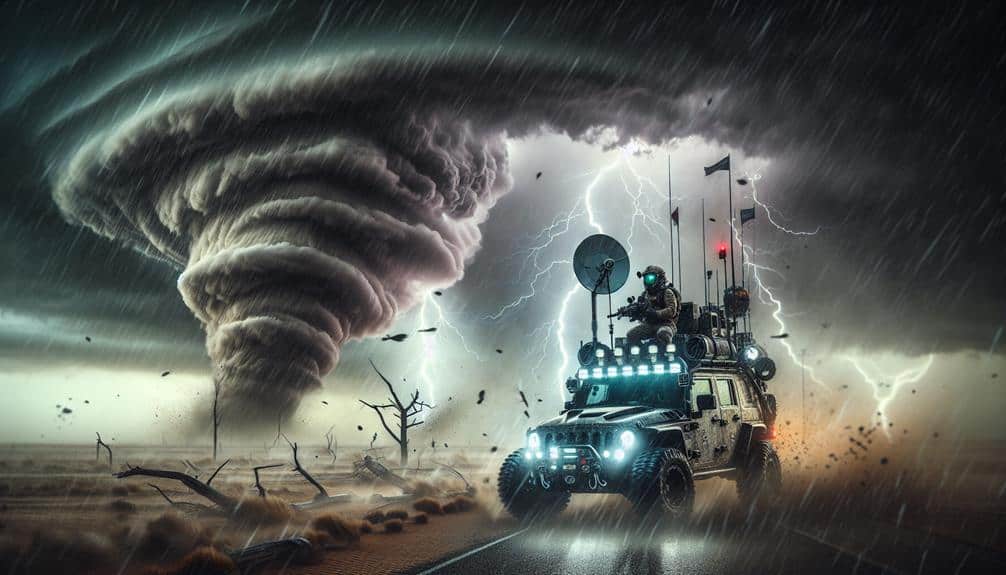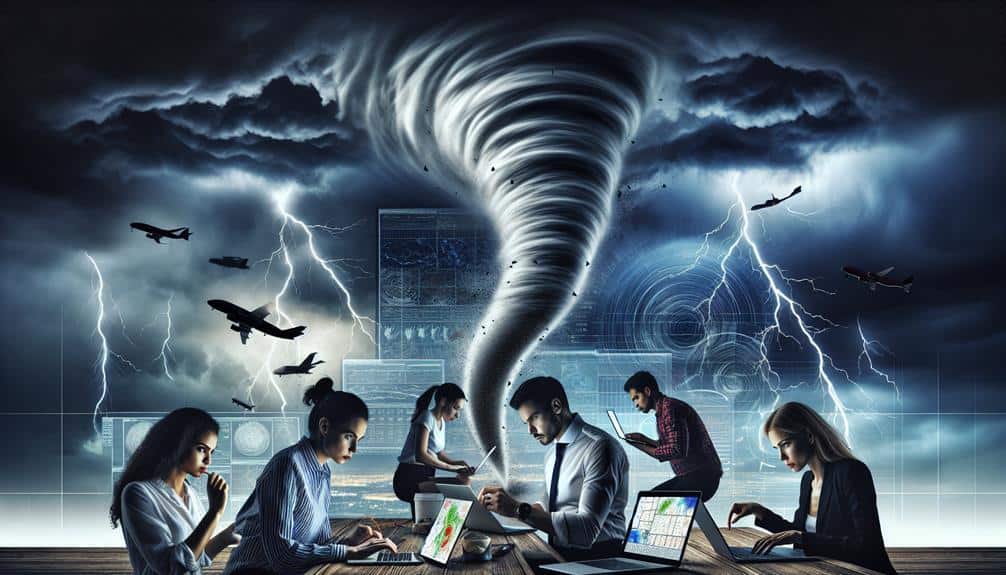Real-time storm tracking data analysis is vital because it guarantees us to deliver precise, timely forecasts using advanced machine learning algorithms. By integrating various data points, we enhance public safety with early warnings and effective disaster prevention plans. We support emergency responders with actionable insights and detailed storm path visualizations, improving decision-making and resource allocation. Real-time data also propels meteorological research, allowing us to analyze storms with greater accuracy and foster global collaboration. For storm chasers, accurate, real-time updates ensure safety and better field data collection. To grasp the full scope of our capabilities, let's explore further innovations.
Key Points
- Enhances predictive accuracy by integrating multiple data points, providing timely and precise weather forecasts.
- Improves public safety through timely warnings and effective disaster prevention plans based on real-time data.
- Supports emergency response teams with actionable insights and clear visual representations of storm paths and impact zones.
- Advances meteorological research by converting raw data into intuitive visual formats, facilitating quick trend identification and global collaboration.
Enhancing Predictive Accuracy
To enhance predictive precision, we leverage advanced machine learning algorithms to analyze real-time storm tracking data. By utilizing these sophisticated tools, we're able to achieve unparalleled data exactness, which is critical for developing robust predictive models. These models incorporate a plethora of data points, from wind speeds to atmospheric pressure changes, guaranteeing that our forecasts aren't only accurate but also timely.
Our approach emphasizes the importance of forecasting accuracy, driven by recent technological advancements in data analytics and computational power. Machine learning algorithms enable us to sift through massive datasets quickly, identifying patterns that might be imperceptible to the naked eye. This allows us to refine our predictive models continuously, adapting to new data and improving our storm tracking capabilities in real-time.
We understand that the freedom to make informed decisions relies heavily on the precision of the information at hand. That's why our data-driven, analytical approach prioritizes both exactitude and reliability. By integrating cutting-edge technology with rigorous statistical methods, we guarantee that our storm forecasts empower individuals and communities to act swiftly and confidently, minimizing potential disruptions and maximizing safety.
Improving Public Safety
Prioritizing public safety, we utilize our real-time storm tracking data to issue timely and accurate warnings, enabling communities to take proactive measures. By providing precise early warning systems, we greatly enhance community preparedness, guaranteeing that residents can safeguard their homes and families against imminent threats.
Our data-driven approach allows for detailed risk mitigation strategies. We analyze storm patterns and historical data to predict potential impacts with high accuracy. This enables local authorities to implement disaster prevention plans effectively, reducing the likelihood of casualties and property damage.
For instance, by forecasting flood zones, we can guide the construction of barriers and evacuation routes well in advance.
Moreover, our analytical methodology ensures that the information disseminated is both actionable and reliable. We continuously update our models with real-time data, refining our predictions as new information becomes available. This iterative process is essential for maintaining public trust and ensuring that the populace remains vigilant yet free to make informed decisions.
Supporting Emergency Response
Our real-time storm tracking data empowers emergency response teams to deploy resources efficiently and make informed decisions during critical situations. By leveraging advanced data visualization techniques, we can provide clear, actionable insights that enable responders to prioritize areas most at risk. This precision is crucial for minimizing the impact of storms and guaranteeing rapid, effective disaster preparedness.
We use high-resolution satellite imagery, radar data, and predictive modeling to create detailed visual representations of storm paths and potential impact zones. These tools help emergency teams identify vulnerable populations, critical infrastructure, and safe evacuation routes. The immediacy of real-time data ensures that decisions are based on the most current information, reducing the margin for error.
Our analytical approach also includes integrating historical storm data to predict potential outcomes more accurately. By comparing current storm patterns with past events, we can offer probabilistic assessments that guide strategic planning. This data-driven methodology enhances the ability to pre-position supplies, allocate personnel, and coordinate with local agencies effectively.
In essence, our robust data visualization and analytical capabilities are indispensable for supporting emergency response. They enable us to act swiftly, decisively, and confidently, ultimately preserving lives and property while safeguarding the freedom and safety of our communities.
Advancing Meteorological Research
Utilizing real-time storm tracking data, we significantly improve meteorological research by providing precise, up-to-the-minute insights into storm behavior and dynamics. This continuous flow of data allows us to analyze storms with unprecedented accuracy, identifying patterns and anomalies that were previously undetectable.
By integrating advanced technology such as satellite imagery, radar systems, and IoT sensors, we can compile extensive datasets that fuel predictive models and simulations.
Data visualization plays a vital role in this process. By converting raw data into intuitive visual formats, we can quickly identify trends and correlations. This not only aids researchers in understanding complex meteorological phenomena but also ensures that our findings are accessible to a broader audience, including policymakers and the public.
High-resolution graphical representations of storm paths, intensity fluctuations, and potential impact zones enable us to communicate risks effectively and make data-driven decisions.
The integration of technology into meteorological research has also democratized data access. Researchers worldwide can now collaborate in real-time, sharing insights and methodologies. This global exchange accelerates the pace of discovery and innovation, ultimately enhancing our ability to predict and mitigate the impacts of severe weather.
Essentially, real-time storm tracking data is revolutionizing meteorological research, offering us the freedom to explore and understand our planet's dynamic weather systems like never before.
Empowering Storm Chasers

With the advancements in real-time storm tracking data, we're empowering storm chasers by equipping them with precise, real-time information that enhances safety and efficacy in the field. Utilizing sophisticated data visualization tools, storm chasers can now interpret and act upon essential weather information instantaneously. This capability is necessary for maximizing both the impact of their efforts and their personal safety.
By leveraging real-time data, storm chasers gain several significant advantages:
- Enhanced Chaser Safety: Immediate access to updated storm paths and intensities helps avoid dangerous situations, enabling chasers to make informed decisions quickly.
- Real-Time Data Visualization: Advanced mapping and graphical representations allow for a clearer understanding of storm dynamics, which is vital for predicting storm behavior and planning routes.
- Improved Communication: Real-time data sharing via mobile applications and networks ensures that chasers and meteorological teams stay in constant contact, facilitating coordinated efforts and timely updates.
- Higher Data Accuracy: Continuous data feeds from multiple sources improve overall accuracy, allowing chasers to rely on the information they receive.
Frequently Asked Questions
How Can Individuals Access Real-Time Storm Tracking Data?
We can access real-time storm tracking data through weather apps, government websites, and specialized services. These platforms guarantee emergency preparedness, data accuracy, and public safety by providing timely weather updates critical for making informed decisions.
What Technology Is Used for Real-Time Storm Tracking?
When we discuss real-time storm tracking, we juxtapose satellite imagery with Doppler radar technology. Satellite imagery gives us extensive, high-level views, while Doppler radar delivers precise, localized data. Combined, they empower us with thorough, timely storm insights.
How Does Storm Tracking Data Affect Insurance Policies?
We analyze real-time storm tracking data to gauge insurance impacts and make policy adjustments. This data-driven approach guarantees we offer adaptable coverage, reflecting current risks and providing our clients the freedom to manage unforeseen weather events effectively.
Are There Mobile Apps for Real-Time Storm Tracking?
Yes, there are mobile apps for real-time storm tracking. They enhance user experience by providing precise, up-to-date data, allowing us to make informed decisions and stay safe. These apps utilize sophisticated algorithms to guarantee accuracy.
What Role Does Social Media Play in Storm Data Dissemination?
Imagine a lifeline cast during a storm; that's social media's impact on emergency response. It boosts public awareness and disaster preparedness, enabling real-time updates and community engagement pivotal for effective emergency management and rapid response.


